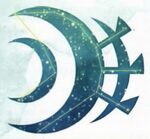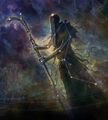Athreos
| Athreos | |
|---|---|
|
The Boatman Servant of the Dead God of Passage The River Guide | |
| Information | |
| Colors |
|
| Species | God |
| Birth, Life & Death | |
| Birthplace | Theros |

Athreos is the God of Passage on Theros. He is associated with white and black mana, and serves as the divine ferryman responsible for guiding mortal souls from the realm of the living to the Underworld. While other gods may intervene in mortal affairs, Athreos remains largely detached, concerned only with preserving the balance between life and death.
Description
Athreos is known as the River Guide, a veiled and silent figure who ferries the souls of the dead across the Tartyx River, one of the five Rivers That Ring the World. He appears as a gaunt humanoid cloaked in ragged robes and adorned with a collection of golden funerary masks. What little of his form is visible appears inhuman: gray, emaciated flesh stretched tightly over a skeletal frame. He does not speak and shows no emotion, conducting his duties with unwavering discipline and without judgment.[1]
Athreos is never seen without his ancient staff, Katabasis, a gnarled length of dark wood. When laid across the surface of a river, the staff transforms into a skiff capable of carrying souls to the Underworld. Despite his humanoid appearance, Athreos is not bound by mortal qualities like gender, identity, or individuality. While many mortals refer to him as male, Athreos does not care for such labels.[1]
Role and Influence
All mortals on Theros are fated to encounter Athreos at the moment of death. He is not a judge of souls; he neither rewards nor punishes. Instead, Athreos reads the truth of each soul and delivers it to its proper place in the Underworld. His responsibility is not open to negotiation—he has heard every plea and rejected them all.[1]
Athreos is invoked in matters of passage, especially at thresholds and transitions. Though best known for ferrying the dead, he is also considered the god of borders, boundaries, and liminal states—phenomena that defy easy classification, such as echoes, phantom sensations, and the moment between life and death. Those about to embark on dangerous journeys, or who stand at metaphorical crossroads, often leave symbolic offerings to Athreos by dropping a coin into a fountain or body of water.[1]
Mortals who reach the riverbanks unprepared—without a token of payment—risk becoming stranded. To prevent this fate, Therosian funerary customs typically include burying or burning the dead with a clay funerary mask and at least one coin. The mask serves to "frame" the deceased's identity for Athreos, while the coin is offered as payment for passage. Athreos accepts any item with personal or monetary value, from minted currency to jewelry, beads, or shells, provided it was given intentionally as preparation for death.[1]
Worship
While Athreos has few temples, his presence is acknowledged in nearly every culture across Theros through funerary rites and death customs. Masks and coins are the most common ritual objects, and bodies are often cremated or buried with grave goods intended for use in the Underworld. Athreos does not respond to prayer or veneration in the traditional sense, and his worship is more about acknowledgment and respect than supplication.[1]
The Feast of the Necrologion, named after the eighth month in the Meletian calendar, is a day of solemn observance during which the living honor the dead. Observants often spend the day in silence, reading ancient memoirs or writing letters for future generations. These acts are intended to maintain memory and legacy, not to influence Athreos himself, who remains indifferent to mortal emotion or sentiment.[1]
Divine Relationships
Athreos is largely aloof from the politics and rivalries of the Therosian pantheon. He takes issue only when other gods interfere with the boundary between life and death. This has led to tensions with Heliod and Erebos; both have attempted, in different ways, to assert dominance over the dead or meddle in the fates of souls, which Athreos opposes.[1]
Despite these tensions, Athreos serves as a stabilizing buffer between the realms of light and shadow, and his presence helps prevent divine conflict from escalating. Thassa, god of the sea, holds a cold respect for Athreos, viewing him as an unwelcome but inoffensive intruder into her domain. If that respect were ever lost, she might attempt to claim control of the Rivers That Ring the World.[1]
Servants and Symbols
Athreos's primary servant is his three-headed hound, Kunoros, who guards the borders of the Underworld. Skeletal griffins are also known to serve him, dispatched to retrieve souls that stray from their path.[2] His staff, Katabasis, is both a symbol of authority and a functional vessel for transporting the dead.
The funerary mask is the most common icon of Athreos in mortal society, along with depictions of his skeletal skiff or riverbank motifs. His name is often invoked in oaths made at borders, crossings, or other thresholds, both literal and symbolic.
History
When Lidia visited Athreos's shrine in the Despair Lands with her son Daxos, the god Erebos sensed the boy's oracular power and sought to claim it for himself. Erebos sent Athreos to take Daxos to the Underworld. Despite Karametra's efforts to intervene, Athreos carried out the command, seizing the boy with his staff. Lidia offered herself in her son's place and was taken to the Underworld instead.[3]
Later, during the Silence of the Gods, Athreos, like the other deities of Theros, became inactive. As a result, souls could not be ferried across the river, leading to a rapid accumulation of Returned—souls trapped between life and death—outside the entrances to the Underworld.
Phyrexian Invasion
During the New Phyrexian Invasion, the Underworld itself came under attack. The Phyrexians attempted to spread their corruption through the realm of the dead, but when they encountered the imprisoned titan Kroxa, they were utterly destroyed by its void-like maw. Recognizing Kroxa's potential to repel the invaders, Athreos shattered the chains that bound the titan, allowing it to lay waste to the Phyrexian forces. To prevent Kroxa from escaping the Underworld again, Athreos sent his hound, Kunoros, to accompany and restrain the titan during its rampage.
Inspiration
The character of Athreos is inspired by Charon, a Greek mythological figure and ferryman to the underworld. The name Athreos may come from the ancient Greek term ăthróos meaning "gatherer" or "amasser".
Story appearances
Gallery
-
Athreos, the Shroud-Veiled
In-game references
- Represented in:
- Associated cards:
- Quoted or referred to:
References
- ↑ a b c d e f g h i Wizards RPG Team (2020), D&D Mythic Odysseys of Theros, Wizards of the Coast
- ↑ Flavor text of Sentry of the Underworld
- ↑ Jenna Helland (April 2014). "Theros: Godsend, Part I." Wizards of the Coast. ISBN 978-0-7869-6556-4.
External links
- The Magic Creative Team (April 02, 2014). "Planeswalker's Guide to Journey into Nyx". magicthegathering.com. Wizards of the Coast. Archived from the original on 2020-11-12.


